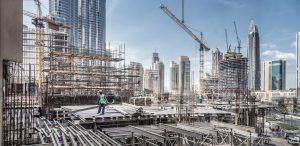What would you say are the top three things your clients should acknowledge in order to avoid disputes during their projects?
The very first word that comes to my mind is ‘Contract’. Read, understand and administer your contract correctly. While studying for my MSc degree in Construction Law and Dispute Resolution at King’s College, London, one of the things I learnt, which has stayed with me since, was “The Contract is King”. Indeed, it is! Lack of practical understanding of the contract provisions, and most importantly, failure to apply specific processes and procedures are, in my opinion, the underlying causes of any big dispute. My advice is to always submit the written communications required by the contract, especially those that relate to a change in scope. Never hesitate to reply to communications highlighting any areas of disagreement. The other party to the contract might well be your life-long friend, but don’t fall into the trap of continuing to treat it as a friend for the purposes of the contract. Always maintain a professional and contractual relationship – after all, good dealings make good friends.
This brings me to the second piece of advice I would like to give – always maintain comprehensive contemporaneous records if you wish to avoid disputes.
I find it very unfortunate and frustrating when clients fail to apply, for example, the progress monitoring procedures prescribed in their contracts – a process that goes hand in hand with delay analysis. Failure to do so results in a lack of retrospective understanding of how the works were executed or the probable areas affected by delay, and in turn leads to disagreements. These disagreements can lead to disputes, which can escalate when referred to dispute resolution forums.
This brings me to the second piece of advice I would like to give – always maintain comprehensive contemporaneous records if you wish to avoid disputes. One might say I sound old fashioned, but “… the importance of records, the importance of records and the importance of records.” lesson that Max W. Abrahamson tried to teach us many years ago, is in reality yet to be comprehended in our highly educated and technologically advanced construction world.
Ask yourself what the real issue is and aim to resolve it.
It is with a sense of disappointment I am sharing this with you; to this day, I am faced, again and again, with disputes where records range from very limited to none at all! Even if they exist, they are often disorganised. Disputes can, more often than not, be resolved by reliance on records that have been kept during the life of the project. Records, their quality and extent, are of primary importance to any dispute avoidance model or dispute resolution process.
You have asked me for three things. The third one is not based on any contractual or planning engineering or management principles we read in textbooks, but it is rather based on logic and common sense: communicate with the other party. Silence will most likely trigger a dispute. Ask yourself what the real issue is and aim to resolve it. Be transparent and initiate a dialogue. Most importantly deal with the problem before it transforms into an unmanageable beast. How? Be creative, brainstorm with your team and consider possible avenues for resolution. Do not be completely restrained by the contract, learn to sometimes look beyond the contractual procedures. Share those potential solutions with the other party. The party you have contracted with is not your enemy, ultimately you need its assistance to resolve the differences as much as it needs yours.
Some instructing solicitors choose to act as the ‘middle-man’ between experts and a party to the dispute.
What took you by surprise when you were first instructed as an Expert? Do you think any changes should be made, for the benefit of clients that are at dispute?
No access to the construction team. This is what took me by surprise. This is what I believe should change for the benefit of our clients.
Some instructing solicitors choose to act as the ‘middle-man’ between experts and a party to the dispute. I appreciate that there are legal and procedural reasons behind this approach but, if “a picture is worth a thousand words”, a one-hour discussion with the project’s participants (where possible) saves hours of searching for facts through project documentation.
Interviewing the construction team assists comprehension of the flow and progress of the works and prevents an analysis from being consumed by software complexity. It also provides confidence that the analysis is progressing in the right direction and acts as a ‘common-sense’ check of the results. Lastly, it is an invaluable help in uncovering evidence for the causes of delay.
What is your preferred method for delay analysis?
The complex and unique nature of construction contracts, which has persisted despite recent technological advancements, means that delay analysts ought to consider project specific criteria when deciding which method of analysis to deploy.
As an expert, I welcome the Society of Construction Law’s decision to move away from the ‘preferred method’ approach (Society of Construction Law Delay and Disruption Protocol, 2nd Ed., February 2017). In my opinion, delay analysts should not have a preferred method. I do not have a preferred method. There is a plethora of methods available to us. The Association for the Advancement of Cost Engineers International (AACEI) recommends nine methods for conducting retrospective delay analysis. Those nine are further broken down into sub-methods which results in a total of seventeen variations for analysing delay. The SCL Protocol recommends six different methods. Five of those can be identified within those recommended by the AACEI.
The complex and unique nature of construction contracts, which has persisted despite recent technological advancements, means that delay analysts ought to consider project specific criteria when deciding which method of analysis to deploy. A number of these are set out in the SCL Protocol. I agree with all of them. However, in my opinion, there are two that bear a disproportionate weight of importance to the others; firstly, the contract conditions (remember… “The Contract is King”) and secondly the nature, extent and quality of available contemporary information. If the contract remains silent on the choice of methodology and approach to delay analysis, then I ask my clients: “Is there a baseline programme? Are there contemporaneous programme updates? Is there an as-built programme?”. That would be the first tier of the factfinding questioning. The second would be: “Are there photographs, videos, progress reports, minutes of meetings, relevant written communications?”…You can see now why contemporaneous records are central to delay analysis. What I have described is by no means an exhaustive list of the information that is normally required. Only after I receive answers to these questions can I conclusively decide on a method to use.
Based on this model the delay analyst determines, on the balance of probabilities, the causal links for the delays suffered ... I see no art or magic in this process!
Is Delay Analysis a ‘Dark Art’?
No, it is not. I do get asked this question a lot. “If it is not, then what is it?” … I hear you asking?
To answer this question, we first need to answer: what is a dark art? I wonder – is it a satirical term used to describe black magic? And if it is, what is black magic?
The Oxford dictionary on my desk tells me that black magic involves “the supposed invocation of evil spirits for evil purposes”. I do not think this is what would normally be meant in this context, although I do think it is used in a semi-satirical way to describe delay analysis; mainly because it is a process that is technically complex, but based on the apparently tangible. It appears as if it should be simple to follow and the answers obvious – but it is normally not simple to follow and the obvious answer is often not the correct answer.
If performed for ‘non-evil’ purposes, independent of the interests of the instructing party (as an expert witness my duty is to be independent), delay analysis is the analysis of facts drawn from contemporaneous records, making use of programme presentation. The programme is an algorithm for scheduling, in other words, it is a mathematical model incorporating logical dependencies, which determine the critical and near-critical paths of the project – and it is crucial in the assessment of delays. Based on this model the delay analyst determines, on the balance of probabilities, the causal links for the delays suffered ... I see no art or magic in this process!
Maria Fisentzou
110 Cannon Street
London
EC4N 6EU
maria.fisentzou@diales.com
Office: +44 207 377 4944
Mobile: +44 7768 895 778
I am a Chartered Civil Engineer and Delay Expert with Diales. I have gained 30 years of experience in the construction industry. Diales is the expert witness division of Driver Group Plc; its expert teams’ specialities include delay analysis, quantum, project management, technical and asset valuation.
At the age of 19, I undertook my very first job placement as a junior site engineer on a residential development near Tower Bridge – a memory that is still vivid in my mind. I found working on building and civil engineering sites highly rewarding, challenging and exciting. That experience prompted me to spend most of my career in the construction sector. Before becoming a delay expert, I took up different roles: that of a Resident Engineer, Construction Manager – “Construction Agent” in the old days – Planning Engineer, Planning and Commercial Manager. I have worked on construction sites in Europe, the Middle East and Asia. Although I am based in London, I am still involved in multimillion-pound international projects.
When I decided to move into the world of dispute resolution, about 11 years ago, I joined Driver Trett. Driver Trett is the consultancy division of Driver Group Plc, within which I hold the position of Technical Director. Driver Trett provides specialist commercial management, planning, programming and scheduling, and project management services. Whereas Diales provides expert witness services.
As a delay expert for Diales, I provide support to the Courts, Arbitral tribunals, and other Alternative Dispute Resolution panels. I have acted as a party appointed delay expert on several projects. I undertake expert appointments for public buildings, including high-rise residential construction, shipbuilding, FPSOs, tunnelling, the oil & gas industry, the off-shore wind and nuclear power sectors. My services involve carrying out delay analysis, preparing independent expert reports and liaising with counsel and instructing solicitors. I have extensive experience in adjudications and arbitrations, and I have also given oral evidence in international arbitration proceedings.
To find more about Maria, please visit: https://www.diales.com/experts/maria-fisentzou/




















